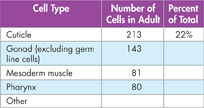Analyzing Data
Cellular Differentiation of C. elegans
The adult microscopic worm C. elegans contains 959 cells. The data table shows some of the different cell types in this worm. Copy the data table into your notebook and answer the following questions.
Calculate Calculate the percentage of the total cell number represented by each tissue or organ listed by using this formula:

Calculate Find both the number of cells and the percentage of the total represented by cells in tissues or organs not listed (“other”). The category includes cells from, among other organs, the intestine. Record the results in your table.

Infer Why does C. elegans make an ideal model for studying cellular differentiation?
Infer Why would it be more difficult to map the differentiation patterns in a different organism, such as a mammal?
Stem Cells and Development
 What are stem cells?
What are stem cells?
One of the most important questions in biology is how all of the specialized, differentiated cell types in the body are formed from just a single cell. Biologists say that such a cell is totipotent (toh TIP uh tunt), literally able to do everything, to develop into any type of cell in the body (including the cells that make up the extraembryonic membranes and placenta). Only the fertilized egg and the cells produced by the first few cell divisions of embryonic development are truly totipotent. If there is a “secret” by which cells start the process of differentiation, these are the cells that know that secret.
MYSTERY CLUE

Some adult salamander cells never completely differentiate. What ability do these cells retain?
Human Development After about four days of development, a human embryo forms into a blastocyst, a hollow ball of cells with a cluster of cells inside known as the inner cell mass. Even at this early stage, the cells of the blastocyst have begun to specialize. The outer cells form tissues that attach the embryo to its mother, while the inner cell mass becomes the embryo itself. The cells of the inner cell mass are said to be pluripotent (plu RIP uh tunt). Cells that are pluripotent can develop into most, but not all, of the body's cell types. They cannot form the tissues surrounding the embryo.
 In Your Notebook Look up the roots that form the words totipotent, pluripotent, and multipotent. How do the roots relate to each cell's ability to differentiate?
In Your Notebook Look up the roots that form the words totipotent, pluripotent, and multipotent. How do the roots relate to each cell's ability to differentiate?
Table of Contents
- Formulas and Equations
- Applying Formulas and Equations
- Mean, Median, and Mode
- Estimation
- Using Measurements in Calculations
- Effects of Measurement Errors
- Accuracy
- Precision
- Comparing Accuracy and Precision
- Significant Figures
- Calculating With Significant Figures
- Scientific Notation
- Calculating With Scientific Notation
- Dimensional Analysis
- Applying Dimensional Analysis





